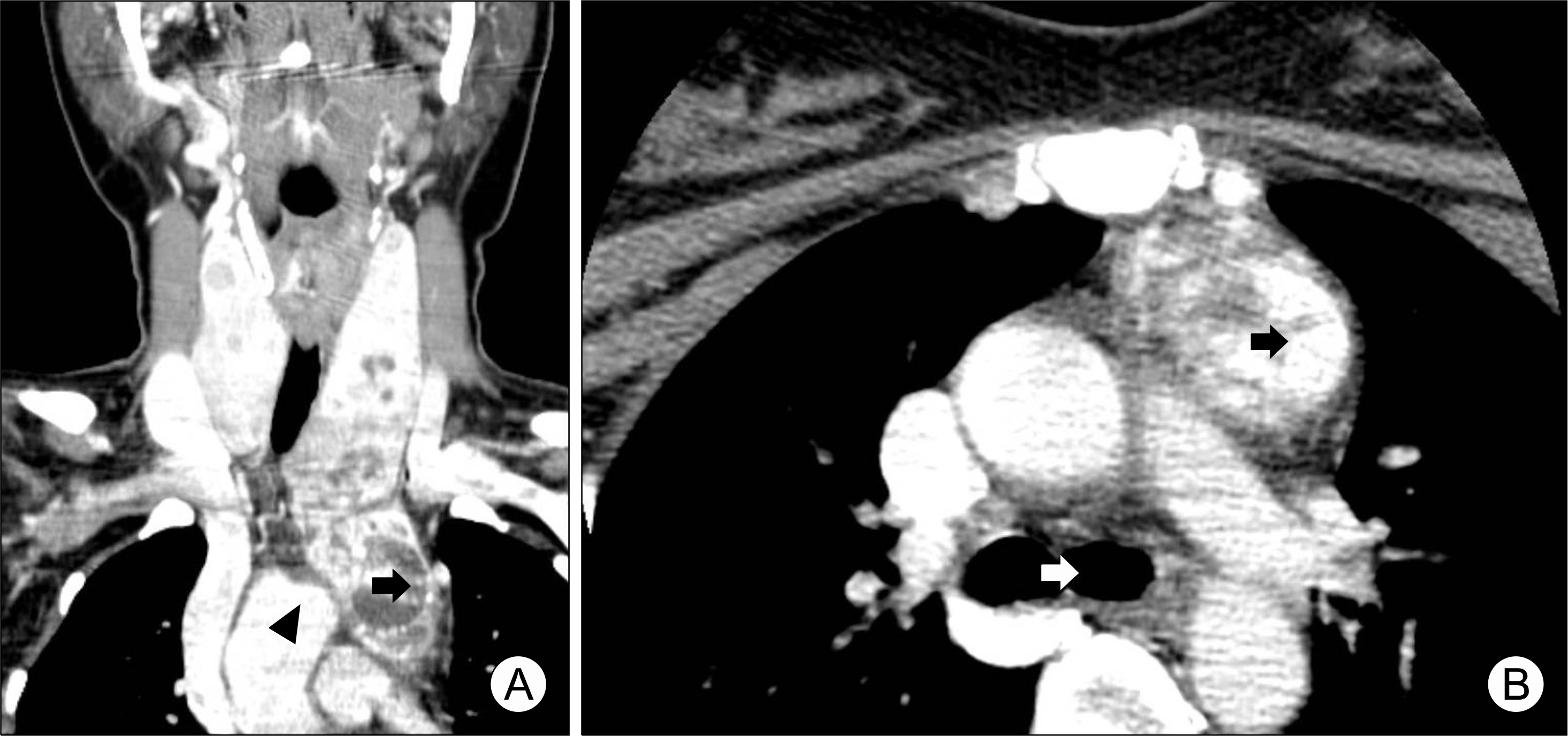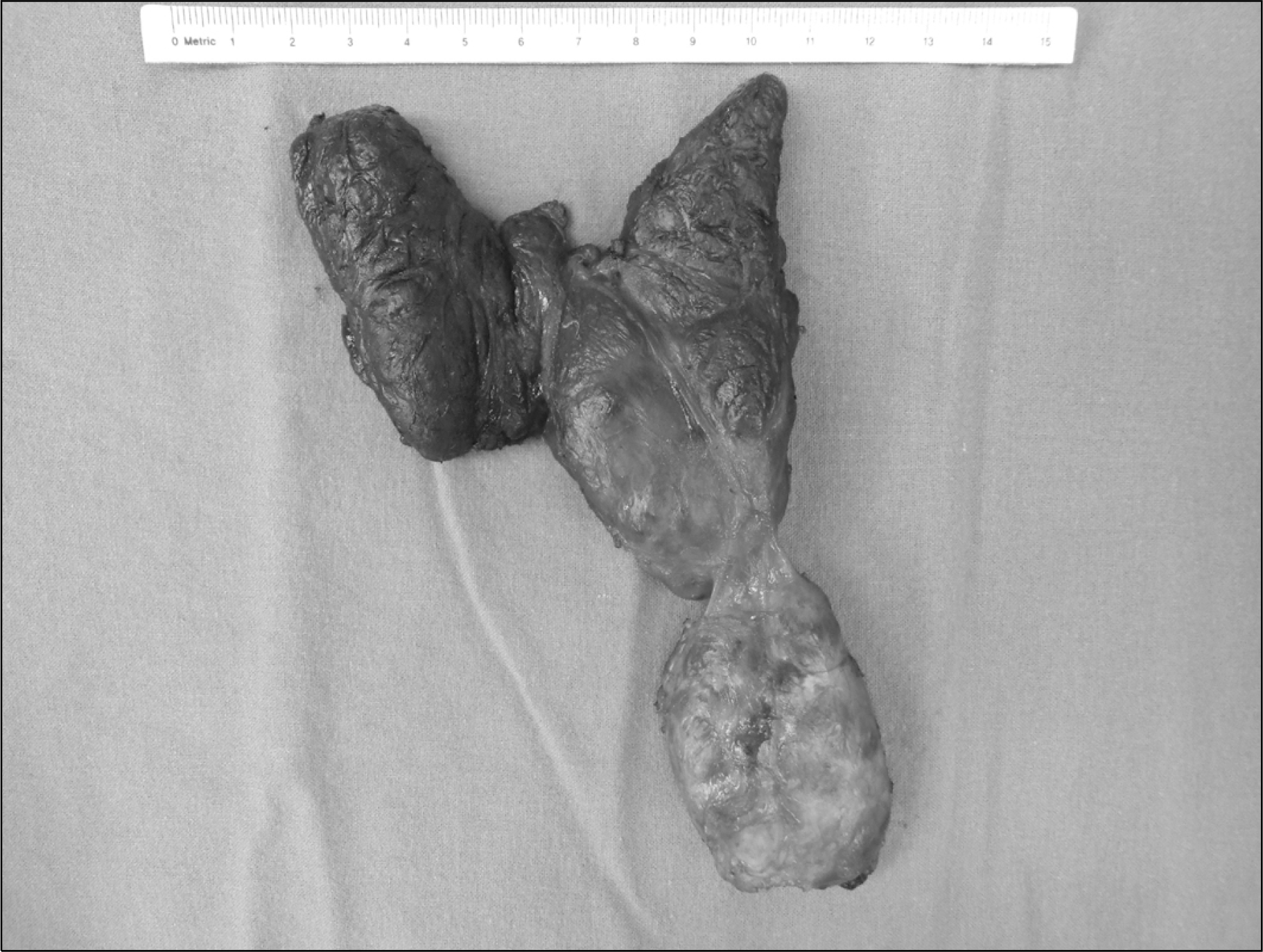Abstract
Substernal goiter is defined as a thyroid mass of which more than half is located below the thoratic inlet. Substernal goiters must be removed surgically due to relation to compressive symptoms, potential airway compromise, and the possibility of an association with malignancy. Thyroidectomy for substernal goiter is usually carried out through a standard cervical approach. However, a few patients with various factors require an extracervical approach, usually by sternotomy. Recently, we successfully removed a substernal goiter that extended to the lower level of the aorta and tracheal carina though the combined cervical and video-assisted thoracoscopic approach. We present this case with a review of the literature.
References
1. Katlic MR, Grillo HC, Wang CA. Substernal goiter. Analysis of 80 patients from Massachusetts General Hospital. Am J Surg. 1985; 149(2):283–7.
2. Agha A, Glockzin G, Ghali N, Iesalnieks I, Schlitt HJ. Surgical treatment of substernal goiter: an analysis of 59 patients. Surg Today. 2008; 38(6):505–11.

3. Erbil Y, Bozbora A, Barbaros U, Ozarmagan S, Azezli A, Molvalilar S. Surgical management of substernal goiters: clinical experience of 170 cases. Surg Today. 2004; 34(9):732–6.

5. Choi JO, Kim YH, Lee JY, Kim YH, Sung TH, Yoo HK. Surgical management of substernal goiter. Korean J Otola-ryngol-Head Neck Surg. 1998; 41(7):935–9.
6. deSouza FM, Smith PE. Retrosternal goiter. J Otolaryngol. 1983; 12(6):393–6.
8. Allo MD, Thompson NW. Rationale for the operative management of substernal goiters. Surgery. 1983; 94(6):969–77.
9. Hsu B, Reeve TS, Guinea AI, Robinson B, Delbridge L. Recurrent substernal nodular goiter: incidence and management. Surgery. 1996; 120(6):1072–5.

10. Netterville JL, Coleman SC, Smith JC, Smith MM, Day TA, Burkey BB. Management of substernal goiter. Laryngoscope. 1998; 108(11 Pt 1):1611–7.

11. Sitges-Serra A, Sancho JJ. Surgical management of recurrent and intrathoracic goiters. Duh QY, Clark OH, editors. editors.Textbook of endocrine surgery. Philadelphia, PA: WB Saunders;1997. p. 262–74.
13. Machado NO, Grant CS, Sharma AK, al Sabti HA, Kolidyan SV. Large posterior mediastinal retrosternal goiter managed by a transcervical and lateral thoracotomy approach. Gen Thorac Cardiovasc Surg. 2011; 59(7):507–11.

14. Sancho JJ, Kraimps JL, Sanchez-Blanco JM, Larrad A, Rodriguez JM, Gil P, et al. Increased mortality and morbidity associated with thyroidectomy for intrathoracic goiters reaching the carina tracheae. Arch Surg. 2006; 141(1):82–5.

15. Sari S, Erbil Y, Ersoz F, Saricam G, Salmaslioglu A, Issever H, et al. Predictive value of thyroid tissue density in determining the patients on whom sternotomy should be performed. J Surg Res. 2012; 174(2):312–8.
16. Gupta P, Lau KK, Rizvi I, Rathinam S, Waller DA. Video assisted thoracoscopic thyroidectomy for retrosternal goitre. Ann R Coll Surg Engl. 2014; 96(8):606–8.

17. Shigemura N, Akashi A, Nakagiri T, Matsuda H. VATS with a supraclavicular window for huge substernal goiter: an alternative technique for preventing recurrent laryngeal nerve injury. Thorac Cardiovasc Surg. 2005; 53(4):231–3.

18. Cerfolio RJ, Allen MS, Deschamps C, Trastek VF, Pairolero PC. Postoperative chylothorax. J Thorac Cardiovasc Surg. 1996; 112(5):1361–5. ; discussion 1365–6.

19. Zhao J, Zhang DC, Wang LJ, Zhang RG. Clinical features of postoperative chylothorax for lung cancer and esophageal cancer. Zhonghua Wai Ke Za Zhi. 2003; 41(1):47–9.
20. Lee YS, Kim BW, Chang HS, Park CS. Factors predisposing to chyle leakage following thyroid cancer surgery without lateral neck dissection. Head Neck. 2013; 35(8):1149–52.

21. Akin H, Olcmen A, Isgorucu O, Denizkiran I, Dincer I. Approach to patients with chylothorax complicating pulmonary resection. Thorac Cardiovasc Surg. 2012; 60(2):135–9.

Fig. 1.
CT scans with contrast enhancement shows heterogeneous enhanced su-bsternal goiter extending into anterior mediastinum. This substernal mass (black ar-row) is located under the tr-acheal carina (white arrow) and aortic arch (black arrow head) (A. coronal view, B. axial view).





 PDF
PDF ePub
ePub Citation
Citation Print
Print




 XML Download
XML Download